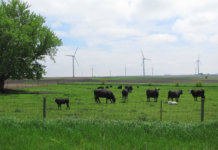 Editor's note: The following is reprinted with permission from the Canadian Wind Energy Association's (CanWEA) wind power blog.
Editor's note: The following is reprinted with permission from the Canadian Wind Energy Association's (CanWEA) wind power blog.
There has been a lot of talk about climate change emission reductions recently with Ontario announcing a cap and trade plan to join Quebec and California in the Western Climate Initiative. Meanwhile, the Canadian Ecofiscal Commission has urged carbon-pricing mechanisms to be set up provincially across Canada. All of this is in the run-up to the next major United Nations conference on climate change, taking place in Paris later this year.
Alberta, of course, is in the midst of an election, and Premier Jim Prentice did not join the recent premiers' meeting in Quebec City due to the campaign at home. Nonetheless, Prentice has recently appointed Diana McQueen as municipal affair minister to oversee Alberta's strategy on updating its climate plan in order to not only achieve the government's 2020 targets of reducing 50 Mt of CO2 emissions, but also to make Alberta an environmental leader. To achieve this, much more will need to be done than what is already in place in the province, and wind energy is well positioned to play a significant role to help.
Wind energy has increasingly become cost-competitive in Alberta. In fact, in 2014, the Alberta Electric System Operator (AESO) listed wind as within 6% to 7% of the cost of combined-cycle natural gas – making it the next lowest-cost option for new supplies. Although gas plants emit only about half as much CO2 per unit of energy than a coal plant does, wind still produces zero. Therefore, any megawatt-hour of coal that is replaced by wind doubles the emission reduction than if that megawatt-hour was replaced by gas – and for roughly the same price.
In fact, as wind's costs have improved since last year, such a cost may actually be less.
So, the logical question is: How much wind could we get on the system to reduce greenhouse-gas (GHG) emissions in Alberta? The answer depends on the physical size of the natural resource, as well as the ability of the electricity system to handle the resource, and the industry's ability to invest and build new projects. When it comes to physical resource, for all intents and purposes, there is no limit to the resource. In fact, there is as much energy in the winds in Alberta as is used to produce electricity in every province west of Quebec combined!Â
In 2006 and 2010, the AESO studied wind integration in Alberta both from a market and a reliability perspective, including up to 4 GW of wind by 2020, and found that Alberta's system could handle it using already-existing technology and infrastructure. This level of development would see wind energy provide 15% of electricity supply. As 2020 is only a few years away, it might be hard to imagine getting that much new wind built by then, but as there are already more than 2 GW of projects in the queue and the industry has demonstrated its ability to quickly deploy new projects, it's not inconceivable that 2.9 GW of wind could be built. This could contribute almost 3 Mt of annual reductions by 2020.
Don't just take it on faith that wind is the responsible choice for Alberta. Utilities in the U.S. are unlocking the power of wind in a bid to maintain reliability, drive down GHG emissions from the electricity sector and stabilize electricity rates for consumers. For example, Xcel Energy, a vertically integrated utility operating in eight U.S. states has been the No. 1 wind provider in the U.S. for 11 years running.
According to Xcel Energy, wind energy is the most affordable source of new electricity supply available today, and is helping keep electricity prices down, all while protecting the environment and shielding rate payers from volatile fuel and environmental compliance costs. Xcel isn't alone either – in Texas, the largest producer of electricity in the U.S., and the U.S. leader in installed wind capacity, wind energy is being unlocked in a grid that is not only isolated from the rest of the country, but has a significant supply from thermal resources such as natural gas and coal.
Achieving wind energy penetration levels already being demonstrated in the U.S. and Europe in Alberta by 2035 would achieve GHG emission reductions of close to 11 Mt per year. These are big numbers that would not only make significant contributions to long-term emissions reductions in the province, but also to demonstrate Alberta's seriousness in tackling climate change to the world.
However, recent market forecasts in Alberta actually foresee the pace of wind development slowing down over the coming decades, taking advantage of only a small fraction of this potential. As Alberta looks to ensure its long-term emissions are being reduced, now is the time to find new ways to unlock the province's vast renewable wind resource.
Image: The Calgary skyline.
Tim Weis is policy director at CanWEA. He can be reached at timweis@canwea.ca.



